Category: General

Review: 2024 Porsche Macan Turbo Electric throws its weight around effectively
· Macan Turbo Electric has 288 miles of range
· It weighs a lot, but Macan Turbo Electric handles well
· With 800-volt architecture, Macan Electric can charge at up to 270 kw
Sporty electric vehicles face a major obstacle: weight. With the Taycan hatchback and wagon, Porsche has been able to—mostly—overcome that issue to create a sharp-handling and engaging car. Now it’s the compact Macan’s turn as it morphs into the Macan Electric.
I recently drove the 2024 Macan Turbo Electric—one of Green Car Reports’ Best Car To Buy 2024 finalists—and found that the transition of Porsche’s top-selling vehicle to fully electric power has its plusses and minuses for dynamics, as energy efficiency of course skyrockets.
Once again, Porsche mostly succeeds in making a sporty and engaging vehicle, even one weighing a few 9-volts shy of 5,400 pounds.
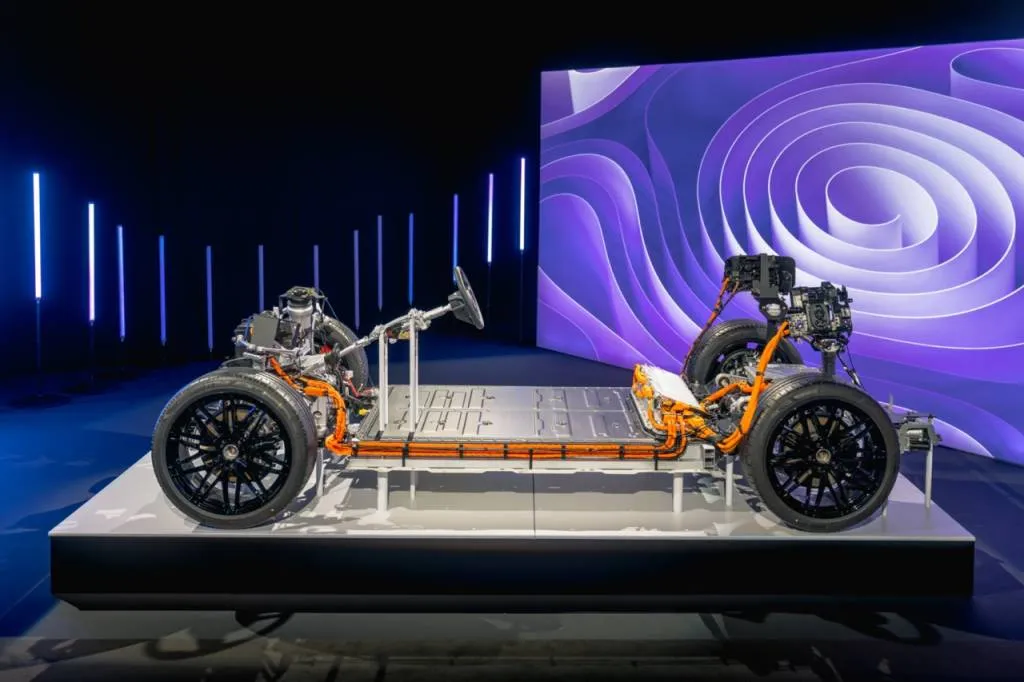
2024 Porsche Macan (electric)
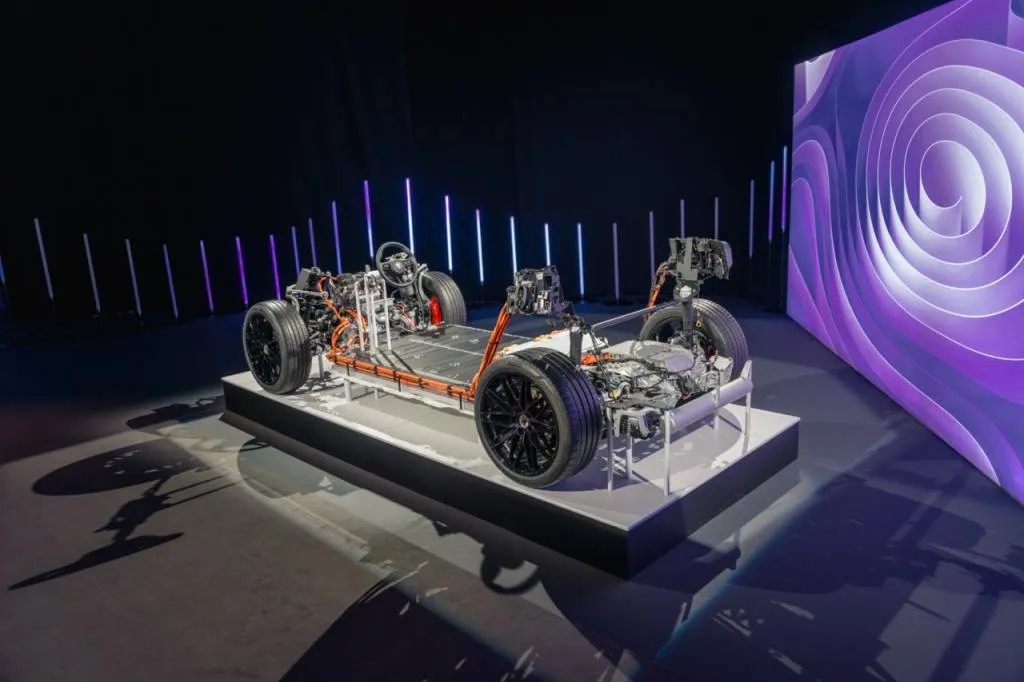
2024 Porsche Macan (electric)
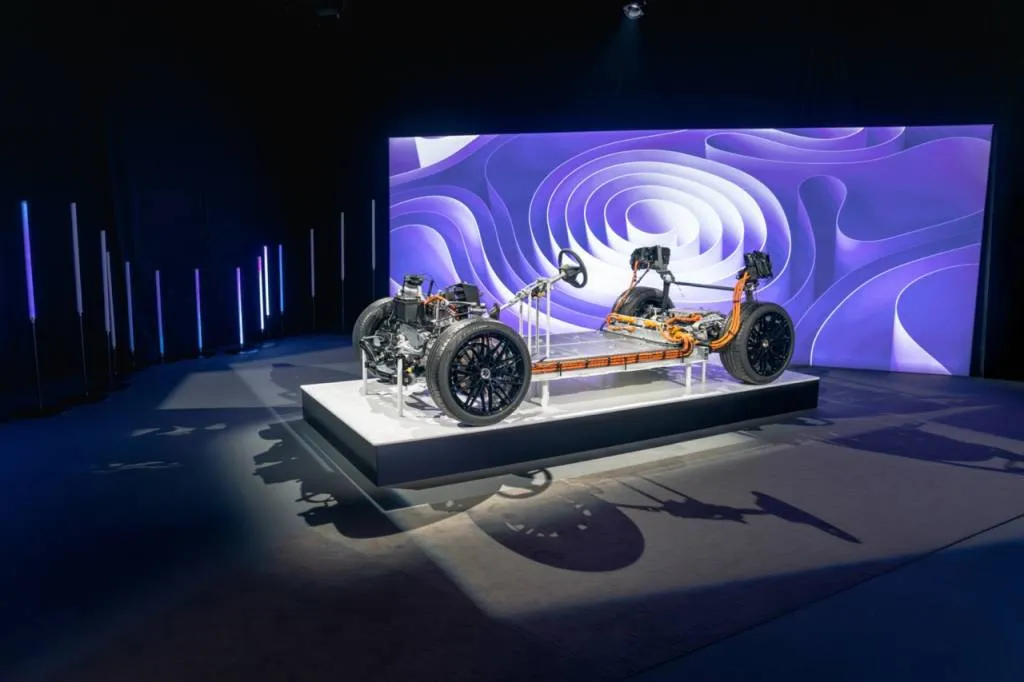
2024 Porsche Macan (electric)
Macan Electric marks debut of PPE
A decade ago, for the gasoline version of the Macan, Porsche engineers had to modify VW Group’s MLB platform to make the Macan handle like a Porsche rather than the very similar Audi Q5. This time around, they were involved from the start to create the new Premium Platform Electric (PPE) architecture.
That left little to do to the platform itself to get the Porsche character. According to a Porsche spokesman, the main change versus other PPE vehicles (most notably the 2025 Audi Q6 E-Tron) was to flip the rear motor 180 degrees to improve the weight distribution and leave space for the available rear-wheel steering rack to fit between the motor and battery. The result is a near-perfect 48:52 front-to-rear weight balance.
A skateboard-style electric platform, PPE makes room for an 800-volt, 100-kwh battery in the Macan Electric with 95 kwh of usable capacity. A duo of permanent-magnet motors, one on each axle, team up to produce 576 hp and 811 lb-ft of torque, which can improve to 630 hp and 833 lb-ft with 10-second shots of overboost. Porsche says the electric motors allow for five times faster control of the all-wheel drive system, and the distribution of power changes with the drive mode.
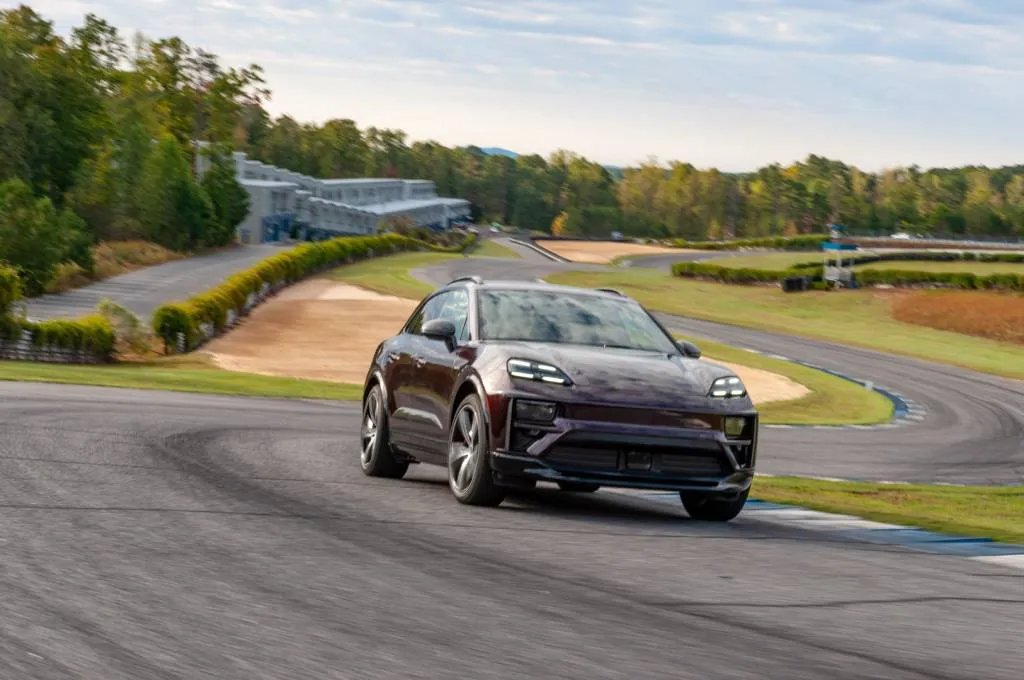
2024 Porsche Macan EV
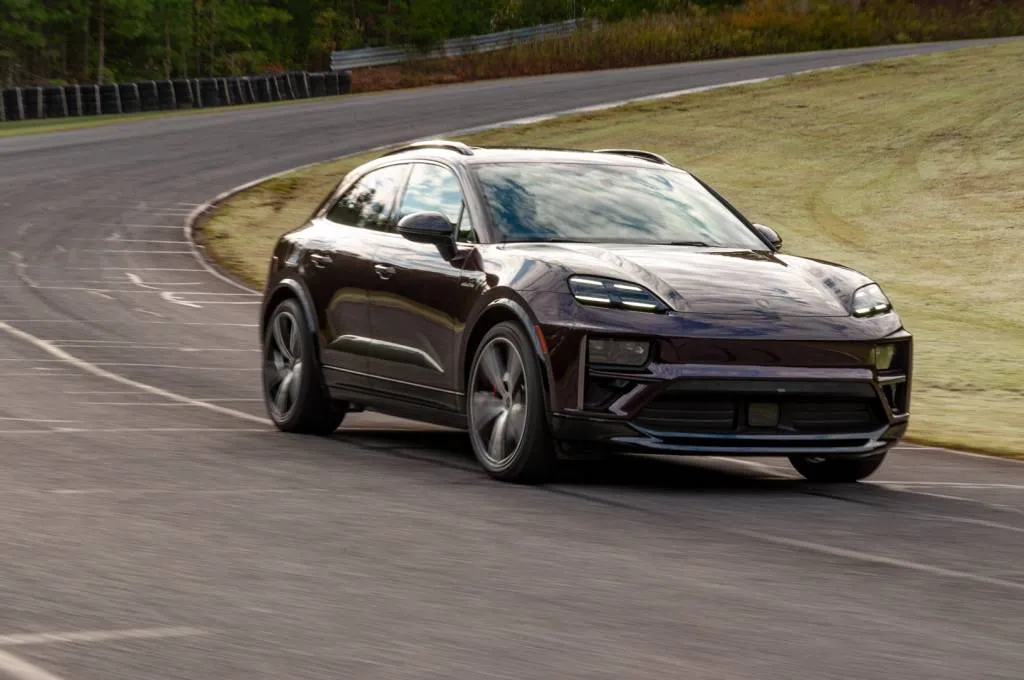
2024 Porsche Macan EV
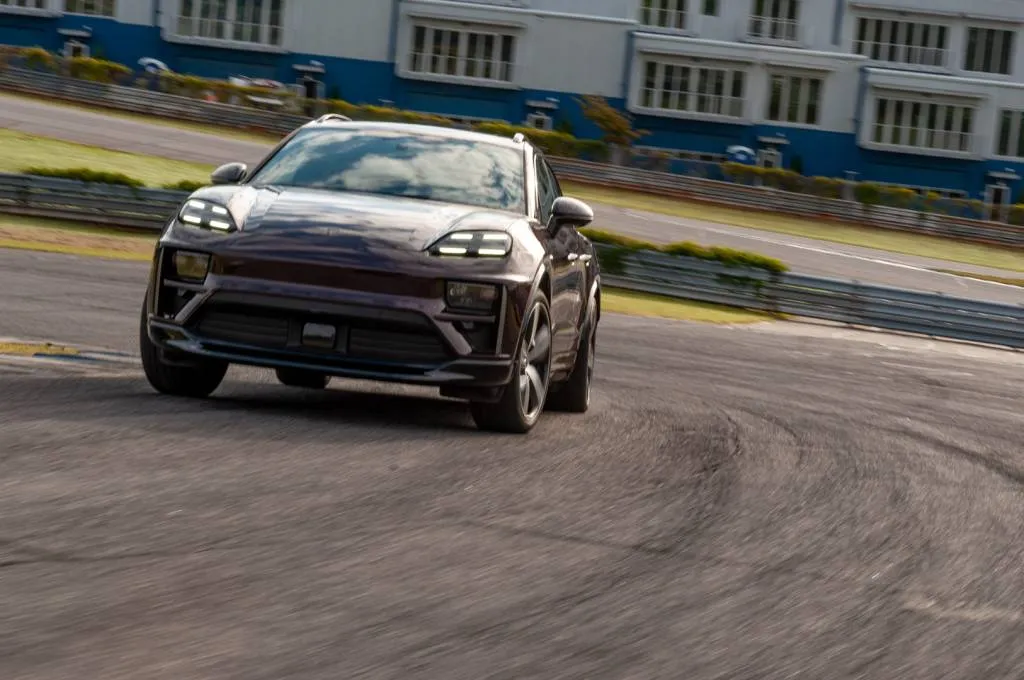
2024 Porsche Macan EV
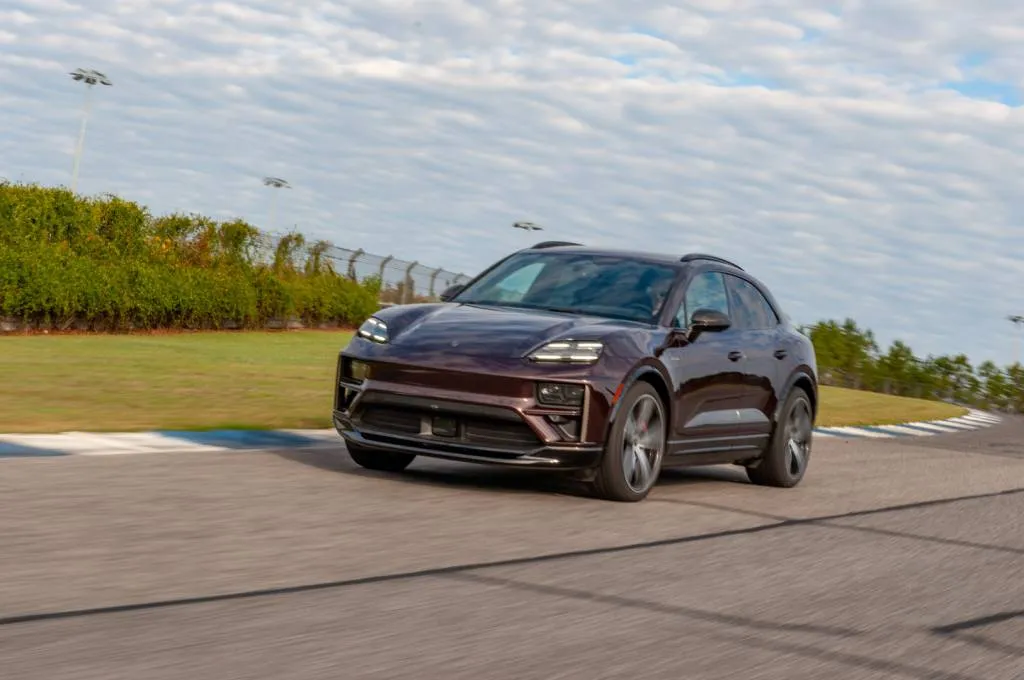
2024 Porsche Macan EV
Macan Turbo Electric: A Porsche-specific driving feel for an EV
Without much work needed on the platform itself, the Macan Electric gets Porsche-specific suspension tuning and a lot of performance equipment to create that Porsche feel, especially in the top-of-the-line Turbo model. Every Macan Electric has a four-corner air suspension, adaptive dampers, and a quick 14.2:1 steering ratio. The Turbo also comes with an electronically controlled locking rear differential and a set of 14.8-inch front rotors with 6-piston calipers (an inch larger than the base model with two extra calipers) and 13.8-inch rear rotors with single-piston floating calipers.
My Turbo tester also came with the optional rear-wheel steering and a set of 255/40R22 front and 295/35R22 rear Pirelli P Zero Corsa summer performance tires rather than the standard 20s on all-seasons. The rear steering can turn the rear wheels up to 5 degrees opposite of the fronts at low speeds and in phase with the fronts at high speeds for more stability.
My drive involved track time at Atlanta Motorsports Park and street drives on twisty northern Georgia roads. The Macan Electric performed admirably in both venues, well mostly. It felt familiar yet different at the same time. The steering had the quick, direct response expected in a Porsche, and the small-diameter steering wheel felt on point as well. While it provided some feel, it wasn’t the kind of telepathic feedback you get in gas-powered Porsches. That big, heavy wafer of battery between you and the road saps feel. The ride was always firm but never harsh, like a Porsche ought to be.
The battery had a noticeable effect on handling, both good and bad. On the track, the low center of gravity worked with the air springs and adaptive dampers to help this compact crossover turn in sharply. The difference, though, was the feel of a quick weight shift below me every time I turned into a corner. From there, the suspension took a set, leaned in a controlled manner (not bad for 6.7 inches of ground clearance in Sport+ mode, down from 7.2 inches regularly), and carved precise lines through even the tightest turns.
The brakes had a natural, progressive feel, and they held up well on the track, which is impressive given they had to arrest 5,393 pounds of SUV. The tires, on the other hand, didn’t. After about 25 laps around the 2.0 miles of Atlanta Motorsports Park, they frayed as big chunks of rubber separated from the edges. That could be the effect of all that weight, it could be the tires, or both. It’s likely both as the same model tires did the same thing on the Hyundai Ioniq 5N.
I was also impressed that track time didn’t sap too much battery or cause the motors and/or battery to overheat. Each four-lap session drained the battery by about 9%, so we were able to go for half a day without having to recharge the Macan Turbo Electric for more track sessions.
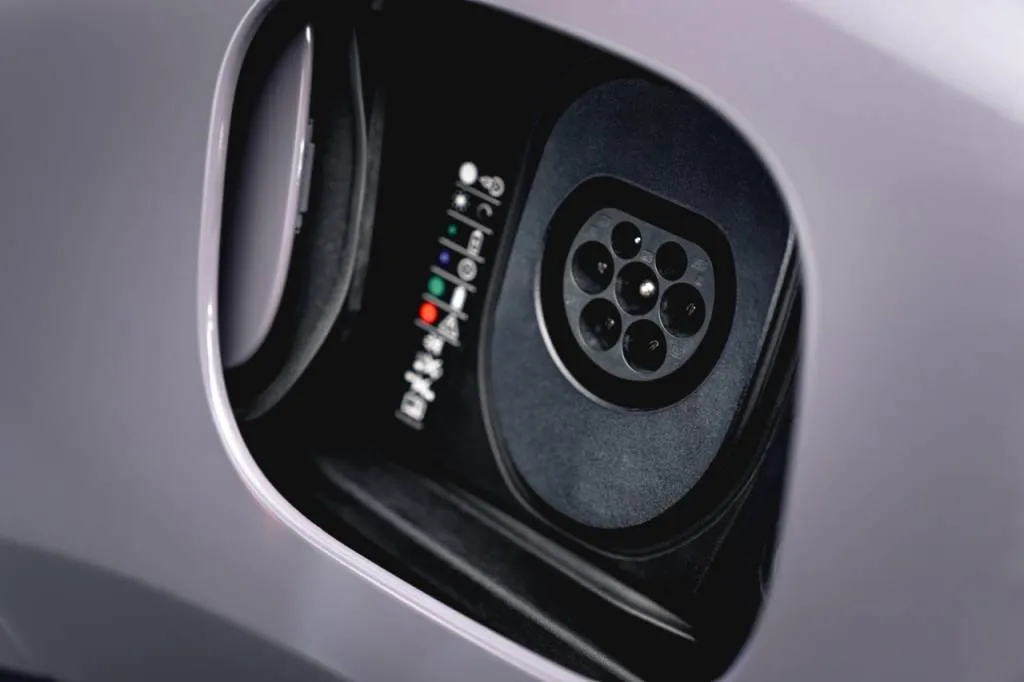
2024 Porsche Macan (electric)
Porsche Macan Electric charging and range
The battery can be treated as a single 800-volt unit or two 400-volt packs. Plug it into a 350-kw fast-charger on the driver’s side and the Macan Electric can charge at a rate of up to 270 kw, which will add 155 miles in 10 minutes or take 21 minutes to go from 10-80%. Make that a 400-volt charger, and software will treat it as two batteries, adding 75 miles in 10 minutes and going from 10-80% in 33 minutes. The charge port on the passenger side is only for a Level 2 (AC) home charger, which requires 10 hours to charge from 0-100%.
Even with all its power, the Macan Turbo Electric has good range. It’s rated for 288 miles on a charge, as is the 502-hp 4S model. The 402-hp 4 model has 308 miles and the 335-hp base model tops out at 315 miles with an efficiency of 2.9 miles per kwh.
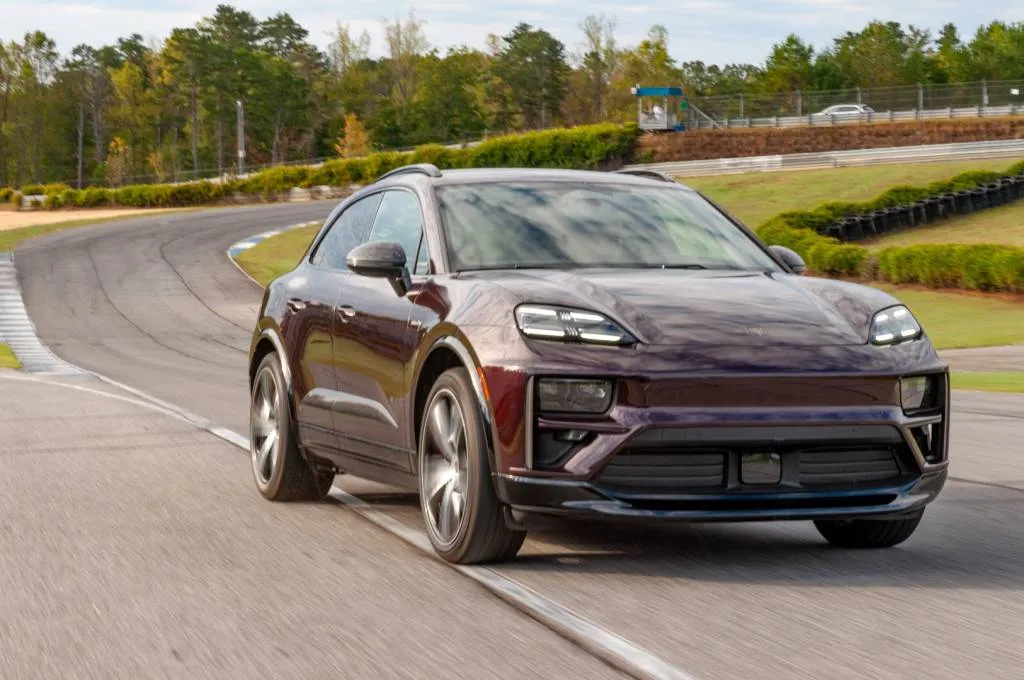
2024 Porsche Macan EV
Macan Turbo Electric: Power galore
The current top Macan gas model is the GTS. Its twin-turbo 2.9-liter V-6 makes 434 hp and 405 lb-ft of torque, which is good for a 4.1-second 0-60 mph run. While the Macan Turbo Electric weighs 1,000 pounds more, its 630 hp unlocks a 3.1-second run to 60 mph when using the standard launch control function. No launch control is needed to tap into that power at any time, though. The power comes on immediately, but it was well controlled on the track and didn’t upset the balance when rolling into the throttle on corner exit or even with dabs of maintenance throttle through longer corners. Thanks to the overboost function, max power was available in every straight because it resets whenever you let off the gas, for instance for a corner.
On the road, it has more power than you’ll ever need and can knock you back in your seat when flooring it in a straight line. It’s also content to toddle along at city speeds with conservative throttle application, and it doesn’t feel like a greyhound that always wants to run.
The tradeoff here is sound. Rather than the growl of the GTS’s twin-turbo V-6 or the throaty howl of a Porsche flat-6, the Macan Electric’s motors make no sound at all out of the box. For $490, Porsche will sell you a Porsche Electric Sport Sound that creates the spaceship whir we’ve come to expect in some EVs. It seems about right, and raises in pitch with more throttle, but doesn’t compare to a good engine sound.
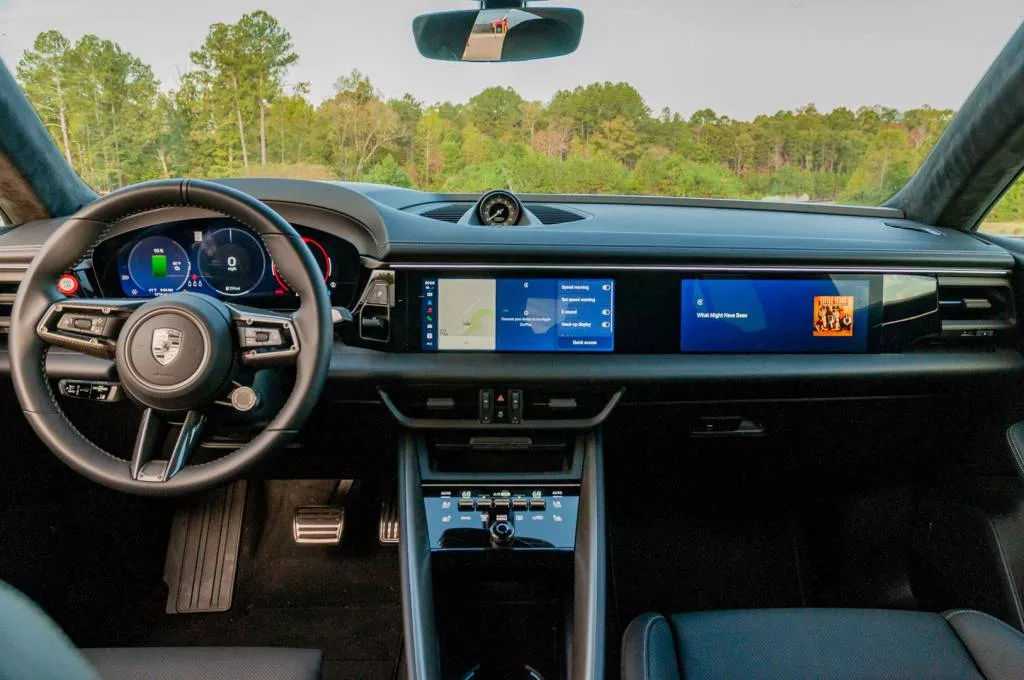
2024 Porsche Macan EV
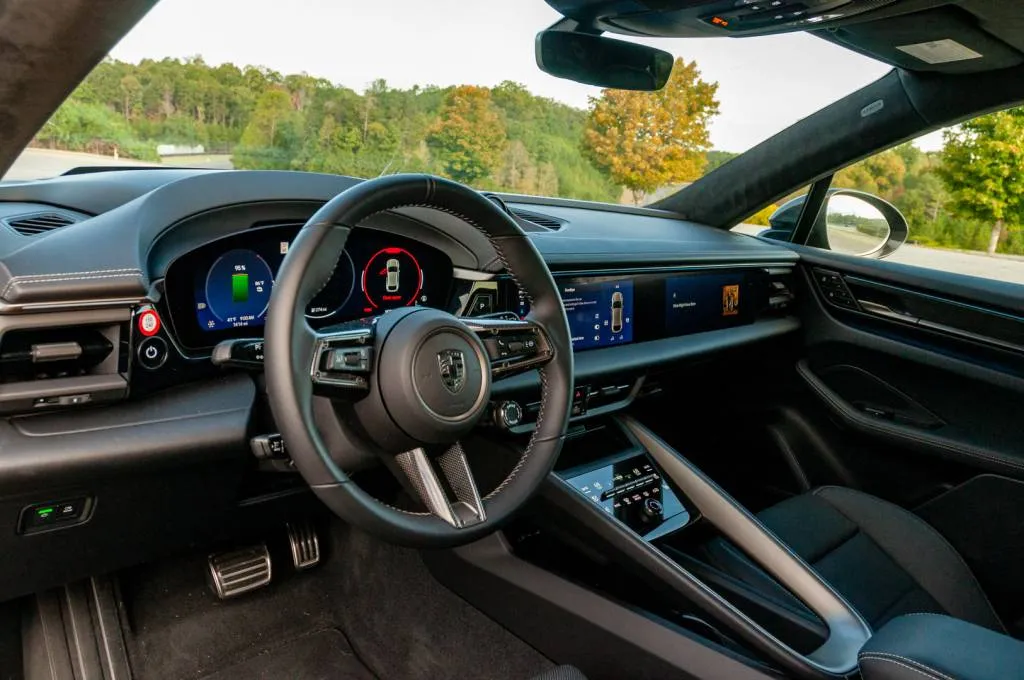
2024 Porsche Macan EV
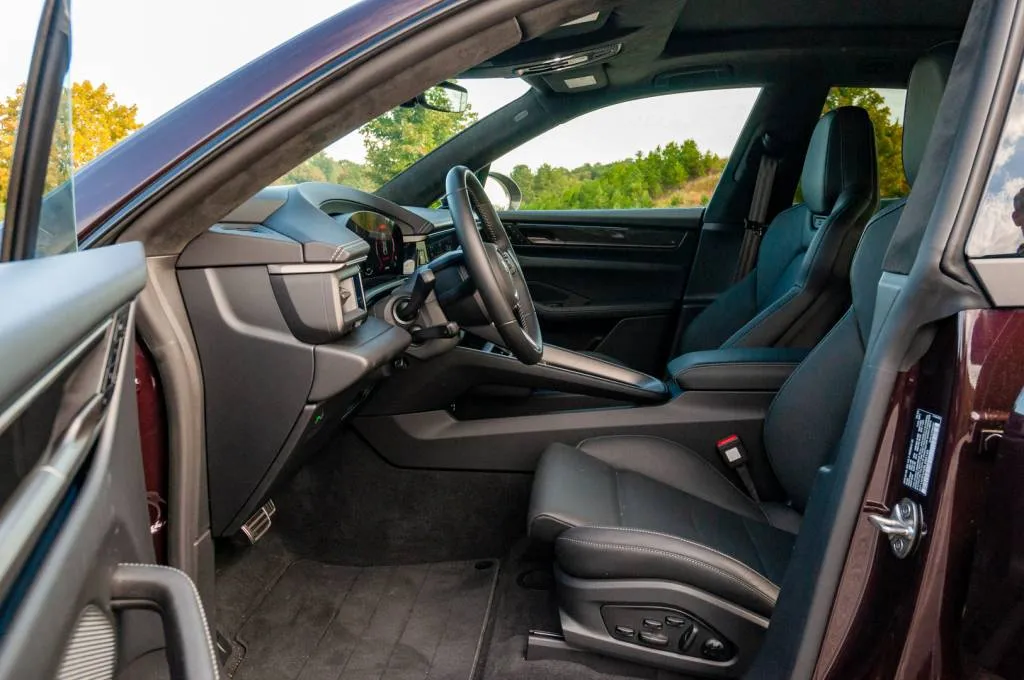
2024 Porsche Macan EV
Macan Electric cabin does it better than gas Macan
The Macan Electric stretches 2.3 inches longer than the gas model on a wheelbase that is 2.4 inches longer. The larger size gives it more rear seat space, though it is still cramped for tall passengers, and Porsche isn’t even pretending it’s meant for five adults as the brand calls it a 4+1 rather than a five-seater. The fast rear roofline also saps some space, as the Macan Electric tops out at 16.5 cubic feet behind the rear seat and 46.5 cubes with the rear seat folded down, figures that trail the gas model’s 17.7 and 53.8 cubes, respectively. A little of that space is added back in the form of a 2.9-cubic-foot front trunk.
Otherwise, the Macan Electric feels much like other recent Porsches as it takes a step forward versus the aging gas version. A small, knurled lever on the dashboard serves as the shifter like it does in the new Cayenne and Panamera, and the dash takes on the stacked horizontal shape of the 911. A small-diameter steering wheel fits the sporty character, and the Sport Chrono clock timer sits atop the center of the dash. Porsche provides few buttons, and the separate haptic touch controls for the climate system feel low-end.
The Macan Electric gets a standard 12.6-inch digital instrument cluster and a 10.9-inch infotainment touchscreen. The gauges aren’t hooded, and the scooped out area looks odd from the passenger seat, but I noticed no sun glare on the screen. Options include a head-up display with an augmented reality overlays and a 10.9-inch touchscreen for the front passenger that can control navigation, phone, and music functions, as well as connected home, steaming, and other apps.
The infotainment screen is home to the Sport Chrono timers, the My Porsche app, and a cloud-based charging planner that the Porsche says works faster than a native version.
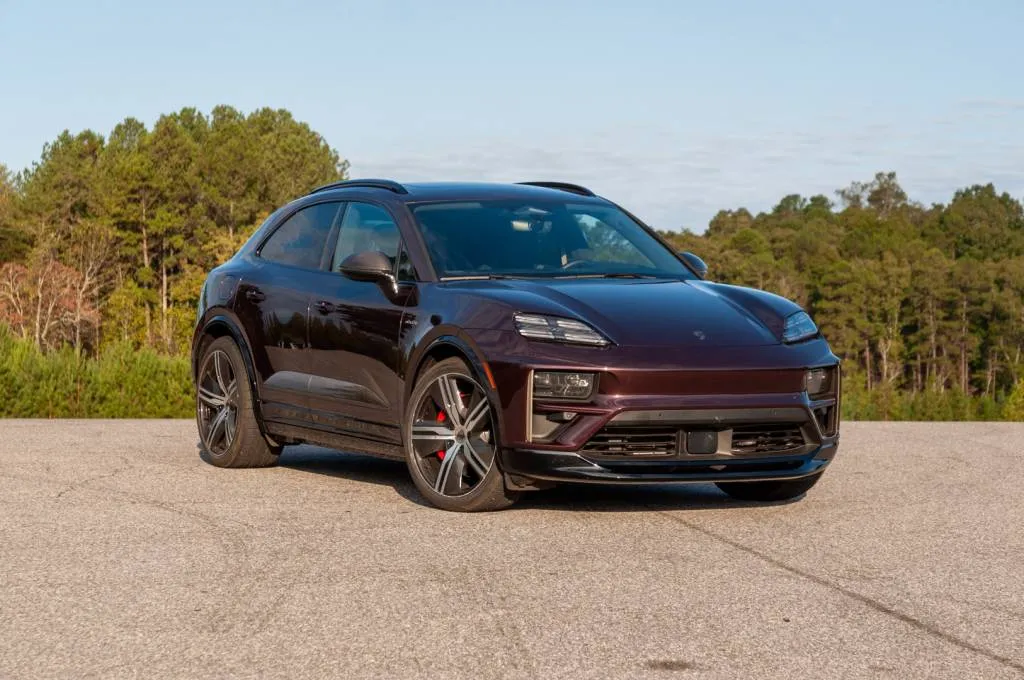
2024 Porsche Macan EV
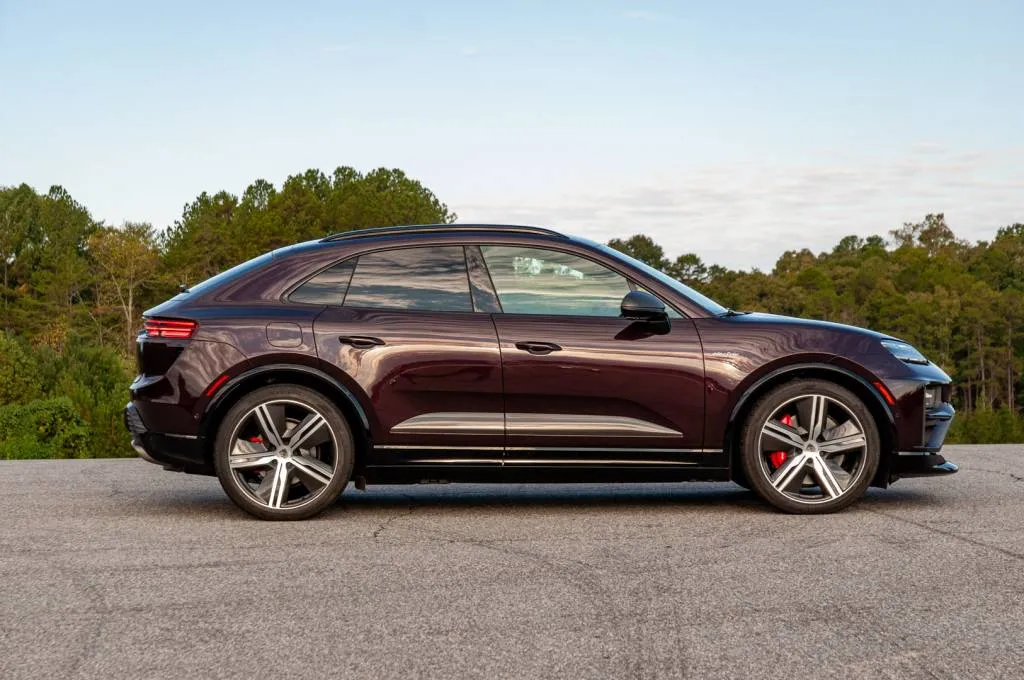
2024 Porsche Macan EV
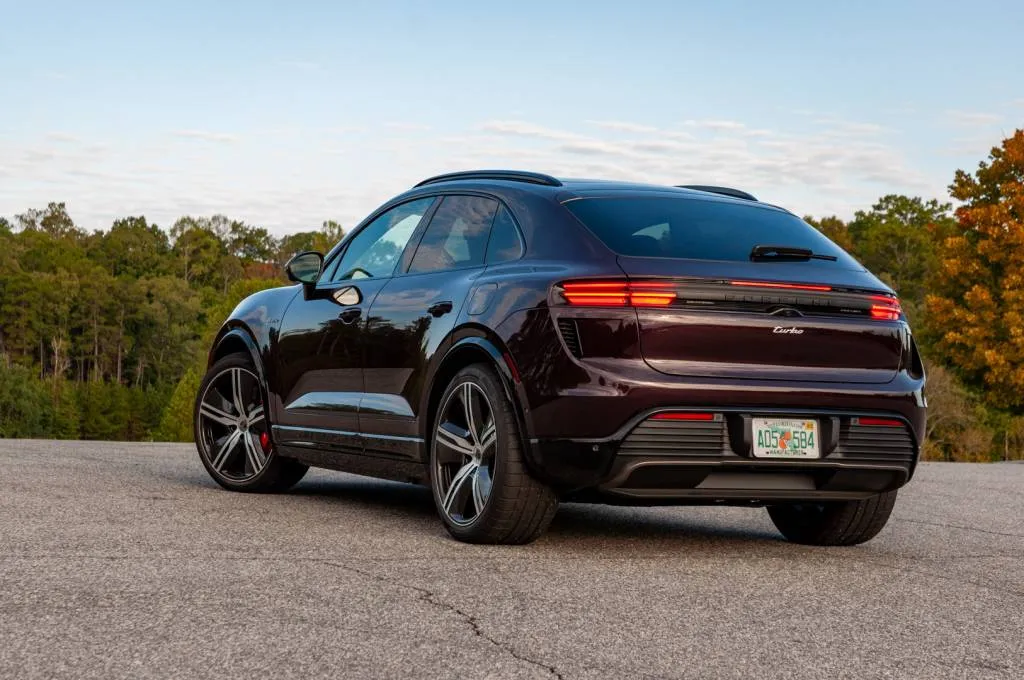
2024 Porsche Macan EV
Porsche Macan Electric price and features
While the 2025 Porsche Macan Electric starts at $77,295 with the addition of a base rear-wheel-drive Macan Electric, the Macan Turbo ups that to $107,295, including a $1,995 destination charge. It comes fully loaded, though, with leather upholstery, 8-way power-adjustable front seats, heated front seats, a heated steering wheel, wireless smartphone charging, ambient lighting, wireless Apple CarPlay and Android Auto, a panoramic roof, carbon-fiber interior trim, a power tilt/telescoping steering wheel, a synthetic suede roof liner, a 14-speaker Bose audio system, and all-season tires on 20-inch alloy wheels.
In true Porsche fashion, Porsche offers many options. My tester had rear-wheel steering ($2,040), the Sport Chrono Package ($980), 22-inch Exclusive Design wheels with carbon-fiber aeroblades ($7,410), the InnoDrive driver-assist system ($960), the passenger display screen ($1,570), the augmented reality head-up display ($2,520), Copper Ruby Metallic paint ($2,490), and the Premium Package $1,300) with four-zone automatic climate control, cooled front seats, and heated rear seats. That brought the price to $130,725.
That’s a heavy price for a heavy vehicle, but the 2024 Porsche Macan Electric wears its weight well and a high price is to be expected for a top-end Porsche. It’s faster than its gas brother, handles almost as well, feels similar inside, and looks like a next-generation model. It does it all while foregoing gas for electrons and, perhaps, by leaving our air a little cleaner in the process.

Affordable Faraday Future EVs will debut at CES 2025
- FX 5 and FX 6 would together span $20,000-$50,000 price range
- California EV maker has shipped prototypes from “collaboration partners” in China
- Would offer EVs with/without gasoline range-extenders; claims to be entering U.S. regulatory testing
Faraday Future plans to show prototypes of affordable electric vehicles at CES 2025, scheduled for Jan. 5-7 in Las Vegas.
The prototypes are part of a new sub-brand called FX (short for Faraday X) that Faraday outlined in a September investor presentation. At the time, the company said it was planning two models called FX 5 priced at $20,000-$30,000 and FX 6 priced at $30,000-$50,000. Both are also slated to be offered with fully electric and gasoline range-extended powertrains.
Those targeted prices are far below the current listed base price of $309,000 for Faraday’s only production model thus far, the FF 91 electric SUV. In contrast to the main brand, which Faraday has struggled to build itself, the FX sub-brand will be an asset-light operation—like the now-defunct Fisker—with limited marketing and an online-only sales model.
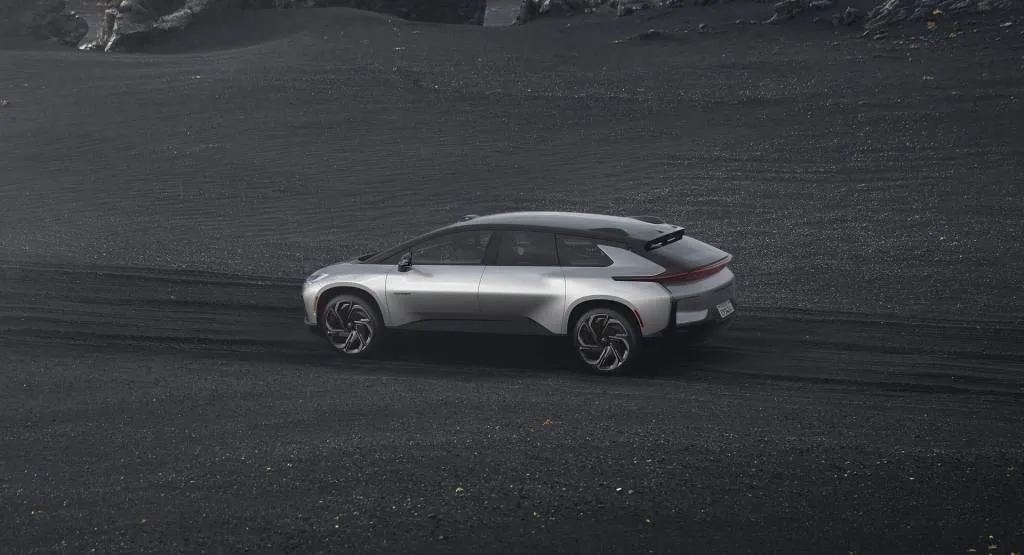
Faraday Future FF91 2.0 Futurist Alliance
Faraday said in a November press release that the FX prototypes were due to leave Beijing for Los Angeles, following up with another release on Dec. 19 confirming that they had reached U.S. shores. After CES, they’ll go to Faraday’s manufacturing facility in Hanford, California, for development work and testing, according to the company.
Faraday promised additional updates about the FX rollout at CES. The company previously said it was targeting a 2025 production start, subject to funding. In a Dec. 22 press release, Faraday claimed $30 million in new financing commitments from “certain institutional investors”—a small drop in the bucket for other automakers, but apparently enough to keep the now-scrappy EV maker going.
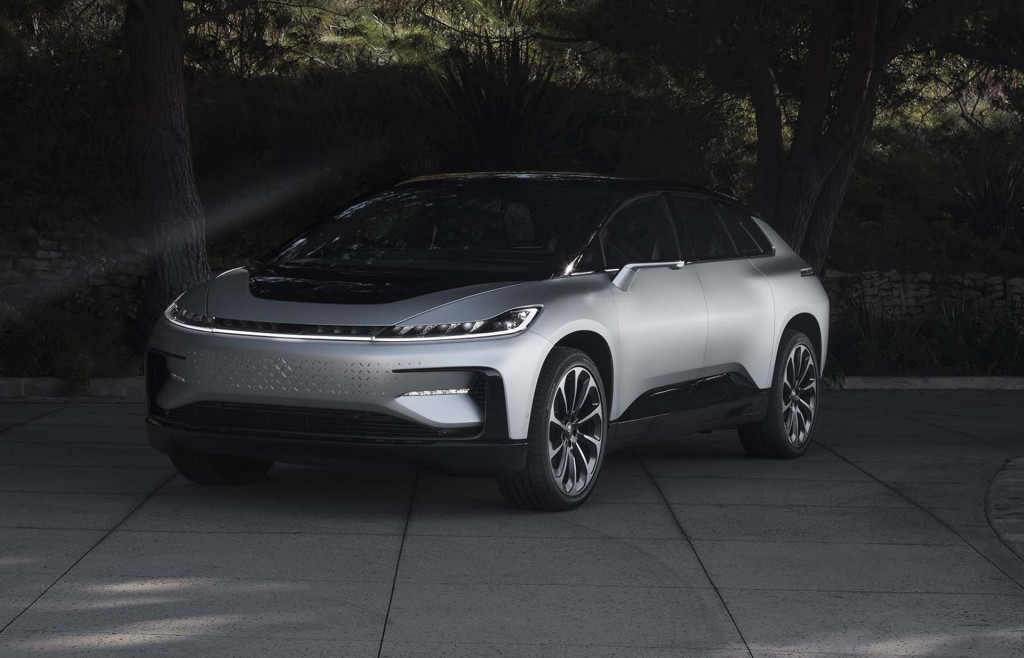
Faraday Future FF91
Faraday has a long-established record of turnover, abrupt strategy changes, and missed timelines. Former GM EV1 chief engineer Pete Savagian, more recently at Canoo, was the senior VP of Faraday Future up until 2018. He was one of several of Faraday’s initial core executives, as former CEO Jia Yueting held tight, to leave the company amid a relationship (and $2 billion lifeline) with Hong Kong based Evergrande gone sour.
Financial issues contributed to a drawn-out launch for the FF 91. It was first shown in production-bound prototype form at CES 2017, but the first customer example wasn’t delivered until August 2023. And that’s with what was intended as a low-volume flagship without the scaled-up volume Faraday is eyeing for the FX EVs.

Ford F-150 Lightning recalled due to detaching suspension
Ford is recalling 11,922 F-150 Lightning electric pickup trucks due to an issue that could cause suspension components to detach, potentially leading to loss of control.
The recall includes 2023 and 2024 models. These vehicles may have front upper control arm ball-joint nuts that weren’t properly tightened at the factory, which could allow the control arm to detach, according to the NHTSA. Control arms extend out horizontally from the vehicle’s frame or body structure and attach to the wheel hub, keeping the hub and its attached suspension components aligned on their vertical axis.
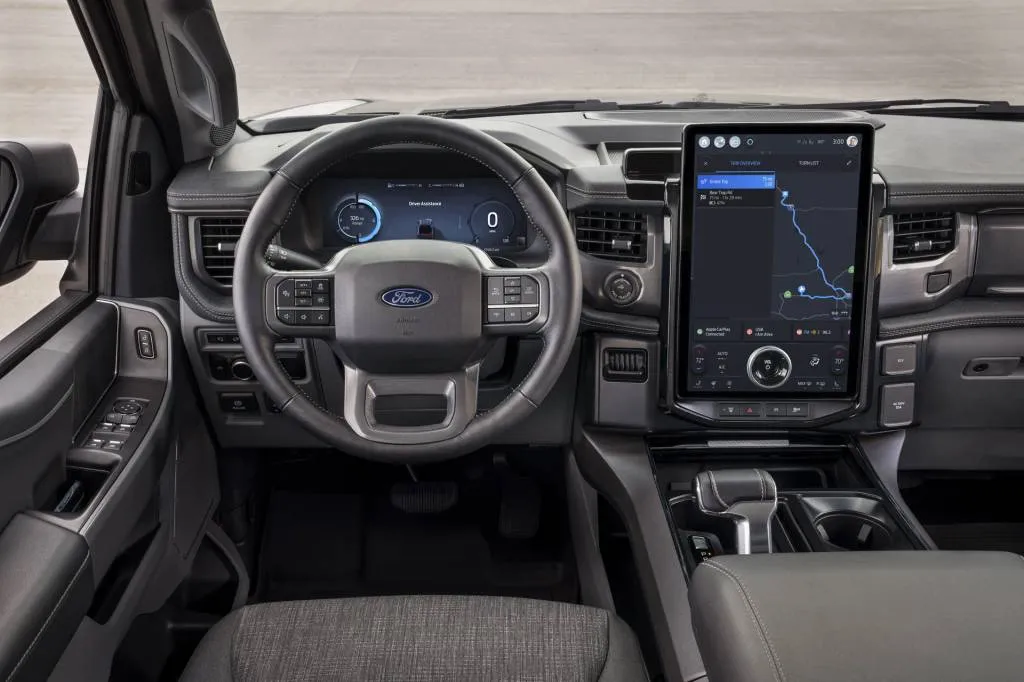
2024 Ford F-150 Lightning Flash
The ball-joint nut represents one of those attachment points, and if it’s loose the control arm can separate, causing loss of directional control and increasing the risk of a crash, the NHTSA noted. If the ball-joint nut is loose or missing, drivers may also notice vibration and hear a clunk or rattling sound during suspension jounce and rebound, the NHTSA said.
Ford told the safety agency that it is aware of one accident attributed to this issue, as well as two field reports and a warranty claim, the latter representing two incidents related to the problem. As for the cause, Ford believes changes in the alignment or orientation of a tool used to attach suspension components may have prevented it from being properly seated during assembly.
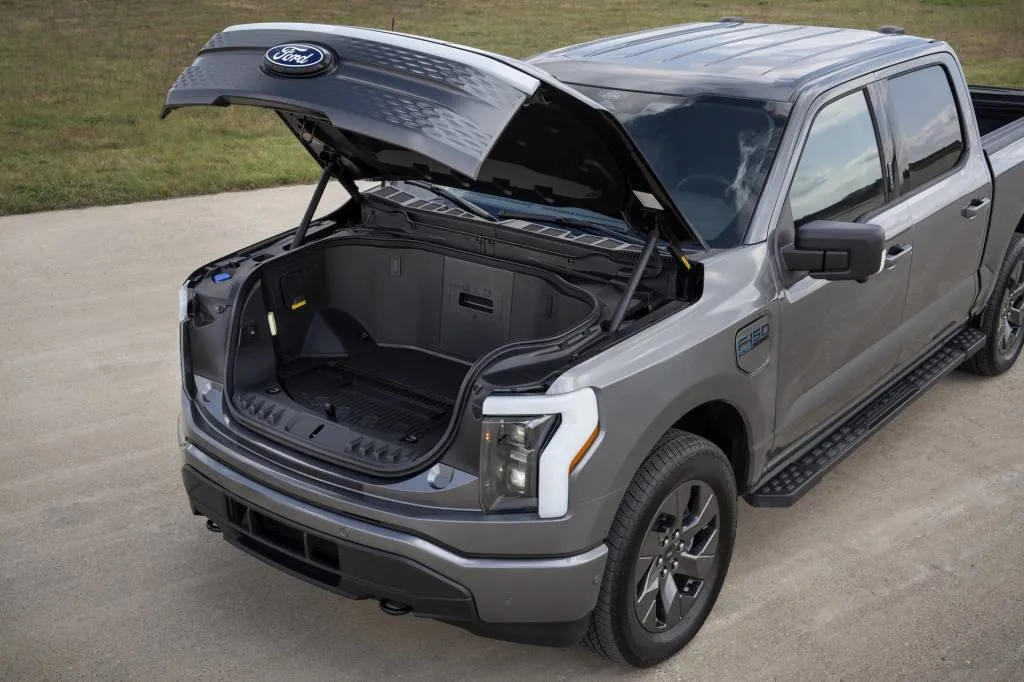
2024 Ford F-150 Lightning Flash
Dealers will inspect the affected ball-joint nut and, if necessary, replace it and/or the related knuckle assembly. Ford expects to mail owner notification letters Feb. 3, 2025. Owners can also call the automaker’s customer service department at 1-866-436-7332 for more information. Ford’s reference number for this recall is 24S76.
The Lightning arrived for the 2022 model year and received a handful of updates for 2024, including a range-boosting heat pump and a new Flash grade positioned between the XLT and Lariat models.

US EV charging kept up with growth, gained reliability in 2024
- Recent data suggests infrastructure has built out to handle peak EV charging demand
- There are about 50% more public charging connectors in 2024 vs. 2023
- Public EV charging is making progress in reliability
U.S. public electric vehicle charging infrastructure kept up with EV sales growth in 2024, and even improved in reliability, according to a study released in early December by Paren, which provides data services for EV charging.
The study looked at end-user experience for fast charging sessions during the Thanksgiving travel week—described as the “Super Bowl of fast charging.”
The study found that the number of charging sessions increased nearly 50% during Thanksgiving week of 2024 compared to the same period in 2023. But the number of charging connectors also increased by about the same amount.
The Thanksgiving week served as 2024’s “pressure test” for the charging sector, as it’s when motorists are out on the highways at once in a way that’s not rivaled by any other holiday time—even the Christmas and New Year’s week, when travel tends to be spread among many days.
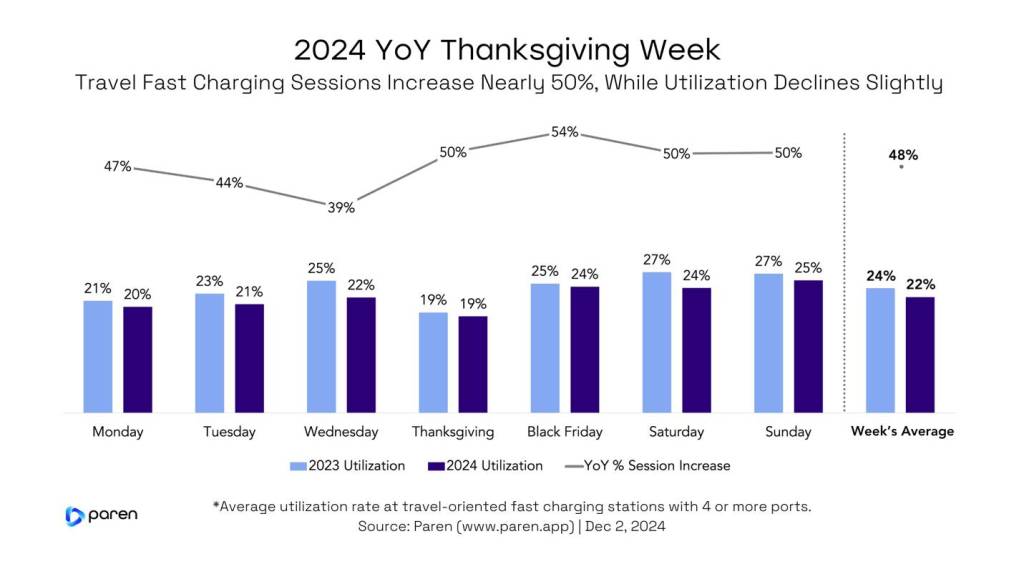
Comparison of Thanksgiving week EV charging sessions and utilization rates (via Paren)
As a result, the average rate of utilization—defined here as a measure of total charging session minutes per connector as a percentage of open hours (typically over a 24-hour period)—declined slightly from 24% to 22%, year-over-year. It shows that infrastructure is keeping up with the increased number of EVs on U.S. roads.
And the number of EVs in the U.S. did indeed increase steadily throughout 2024, with sales up by more than 10% year-over-year in the latter months of the year, and EV market share inching closer to 10% of the overall U.S. light-vehicle market. But 2024 has definitely been a year in which infrastructure gets out ahead of sales growth for EVs—surely a good thing to set the stage for the market. Lack of public chargers was a dealbreaker for nearly half of shoppers in a 2023 J.D. Power survey.
The progress is due in part to lots of filling-in of road-trip fast-charging stations across the nation, allowing far more than the couple of cross-country routes that existed just a few years ago. Electrify America has also tested the idea of limiting fast-charges to 85% at busy stations, and networks seem to be getting smarter about when they need more chargers. For instance, Tesla is adding temporary Superchargers to ease one of the busiest times.

Love’s Travel Stop EV charging
Paren also saw increased reliability, based on the company’s own index that emphasizes the frequency with which drivers are able to successfully initiate and complete charging sessions. This saw an increase of 3.4 percentage points compared to last year, reaching 85.5%. But it’s unclear how much further progress will be made in building out reliable public charging infrastructure over the next few years.
A 2023 Energy Department study suggested that we may need as many as 182,000 publicly-accessible DC fast-charging ports by 2030, to support anywhere from 30-42 million EVs on the roads by then. But given the outcome of the election, it may give infrastructure another chance to work ahead.

Report: Quirky Toyota Previa minivan returning as PHEV, with EV variant
- The Toyota Previa was the automaker’s minivan in the ’90s
- Toyota might bring back the Previa nameplate
- The resurrected Previa might feature electrified powertrains
With its aerodynamic shape and mid-mounted engine, the Toyota Previa minivan remains one of the Japanese automaker’s most daring designs. And it might return with plug-in powertrains.
According to a report in Japan’s Best Car magazine spotted by Forbes, a new Previa is slated for a 2026 launch using the TNGA-K platform that underpins the Toyota Camry, Crown, and RAV4, among others, with the intention of accommodating both plug-in hybrid and all-electric powertrains. A hydrogen fuel-cell powertrain was also reportedly considered but the discarded.
This report, which is based on conversations with an anonymous Toyota source, doesn’t mention the U.S. market. But the fact that the TNGA-K platform is already homologated for use here in so many other models could perhaps give Toyota a head start on making the new Previa U.S.-ready.
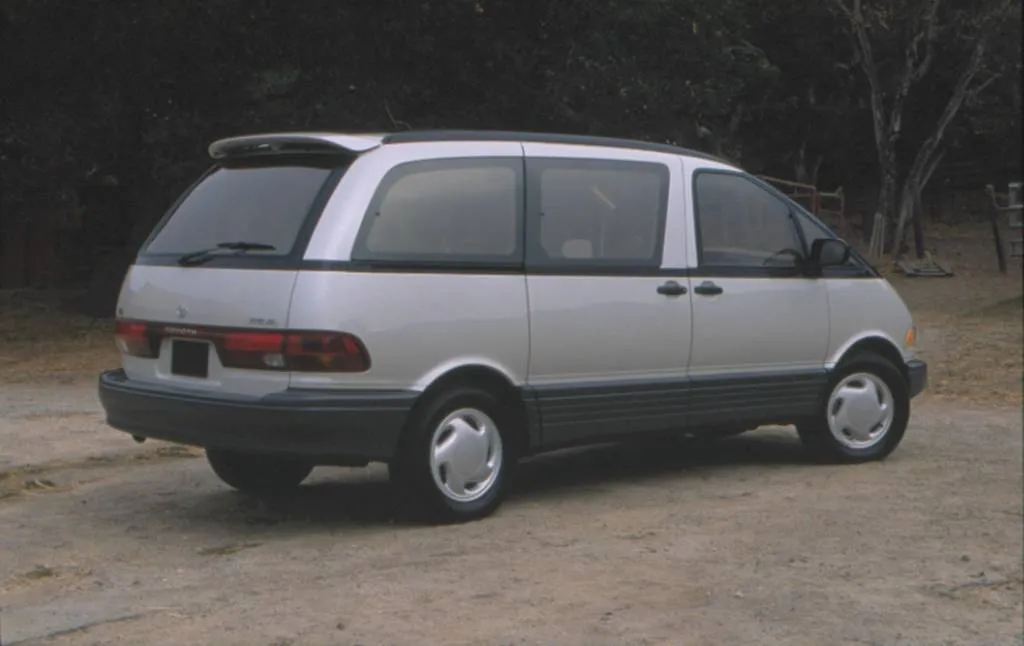
1991 Toyota Previa
Granted, the original Previa wasn’t very successful in the U.S. While it gave Toyota an up-to-date entry in the then-booming minivan segment, sales gradually tapered off from its introduction in 1990 to its discontinuation in 1997. Just 3,780 were sold in that final year, Forbes notes, before the Previa was replaced by the more conventional Toyota Sienna.
The Previa stood out thanks to its rounded exterior, often described as egg-like in period. The new Previa will reportedly feature similar styling, while offering seating for up to seven. If it reaches the U.S., it will be a counterpoint to the Sienna, which is now hybrid-only, but still more conservative in design.
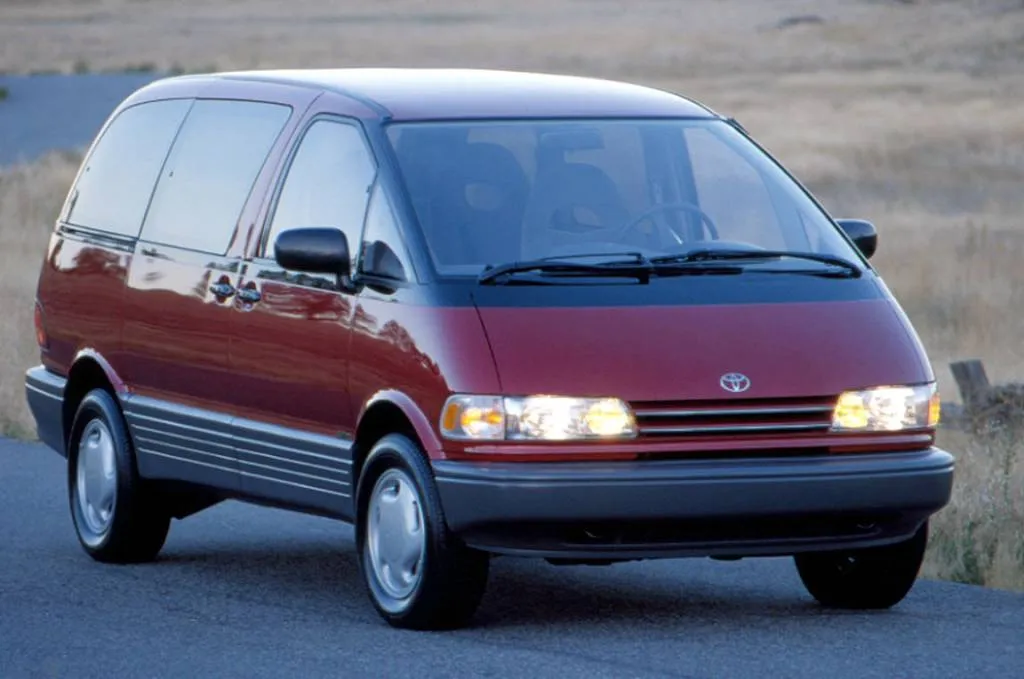
1991 Toyota Previa
Among U.S.-market minivans, all but the Honda Odyssey have switched to hybrid powertrains. The Chrysler Pacifica Hybrid has been a plug-in hybrid for years and as we’ve seen, can go more than 30 miles without the engine.
For the U.S., the Volkswagen ID.Buzz is the first time the minivan—or passenger van—has gone all-electric. But it might not be alone soon. Kia has teased another quirky possibility in the PV5, one of a series of electric vans based on an extremely modular architecture. And an all-electric Chrysler minivan is in the works—potentially as soon as 2027.

Kia EV9 recalled due to missing seat bolts
Kia is recalling 22,883 EV9 electric SUVs because they may be missing mounting bolts for their second- and third row-seats.
The EV9 arrived in the U.S. as a 2024 model and is currently being sold here as a 2025 model. The recall includes a mix of vehicles from both model years that may have left the factory with missing seat bolts due to an error by an assembly-line worker, Kia told the NHTSA. All of the affected vehicles were assembled in South Korea; Kia began building EV9s at its U.S. plant in June, but has only produced small numbers of the SUVs there.
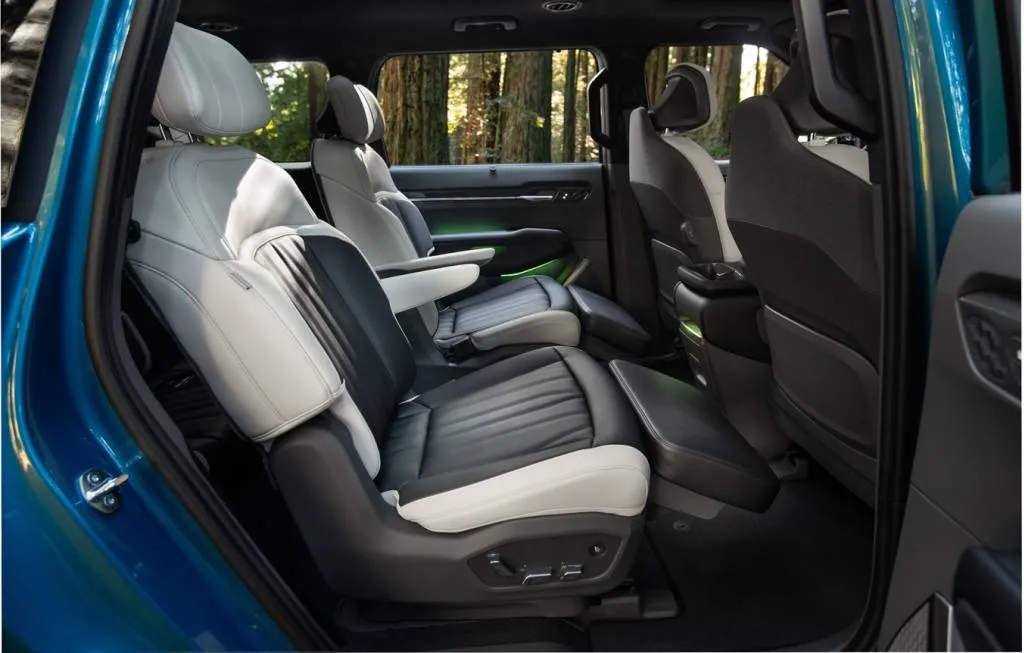
2025 Kia EV9
Without these mounting bolts, seats may not be able to properly restrain occupants in the event of crash, increasing the risk of injury, the safety agency said. Owners may also notice ratting or looseness of the seats if bolts are missing.
Kia estimates that just 1% of the recalled vehicles are missing the bolts in question, and told the NHTSA that it is not aware of any crashes, injuries, or fatalities related to this issue, which was discovered during a quality-control inspection.
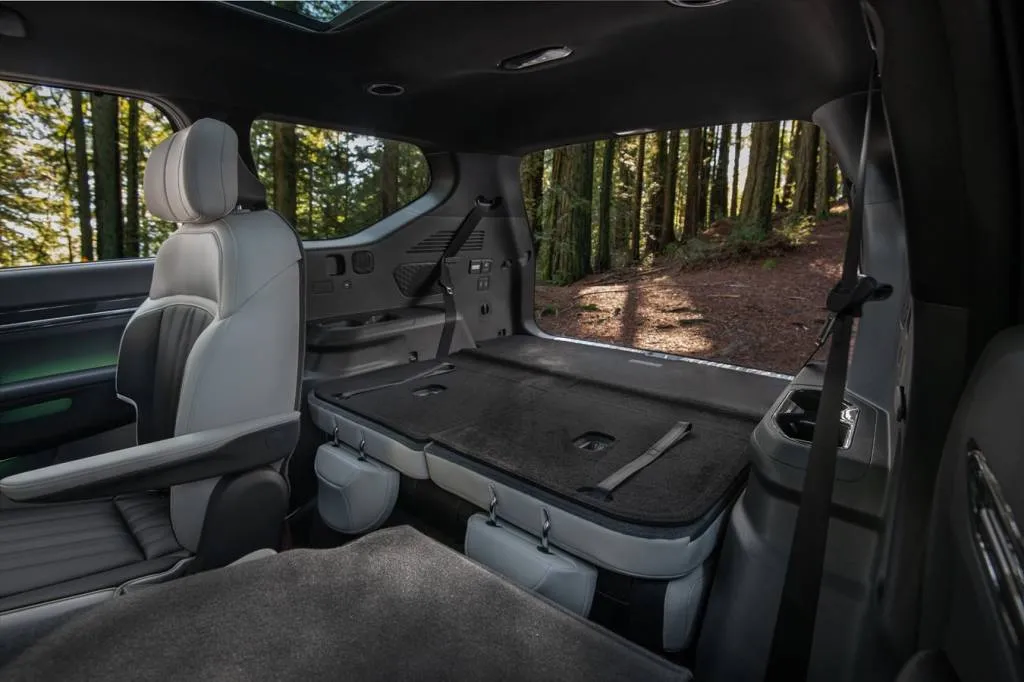
2025 Kia EV9
Dealers will inspect the seats and replace any missing bolts free of charge. Kia plans to mail owner notification letters Jan. 24, 2025. In the meantime, owners can contact Kia customer service at 1-800-333-4542 for more information. Kia’s reference number for this recall is SC329.
This recall follows two in October. One addressed a remote parking system issue in 12,400 vehicles from the 2024 model year equipped with that feature. The other addresses a software issue in both 2024 and 2025 models that could cause digital instrument clusters to fail.

GM proposes making prismatic EV batteries differently
General Motors is investigating a new way of configuring prismatic battery cells to improve cooling characteristics.
A patent filing from the automaker published by the United States Patent and Trademark Office (USPTO), dated Dec. 26, 2024 but originally filed by GM Jun. 23, 2023, details stacking of layers in an inverted “U” shape, as opposed to the rolled or stacked layers used in current prismatic cells.
This format creates higher thermal conductivity in the horizontal direction in the upper part of the cell for better heat dissipation, as well as in the vertical direction near the bottom of the cell, potentially increasing the effectiveness of cooling systems when they’re installed in a pack, GM claims.
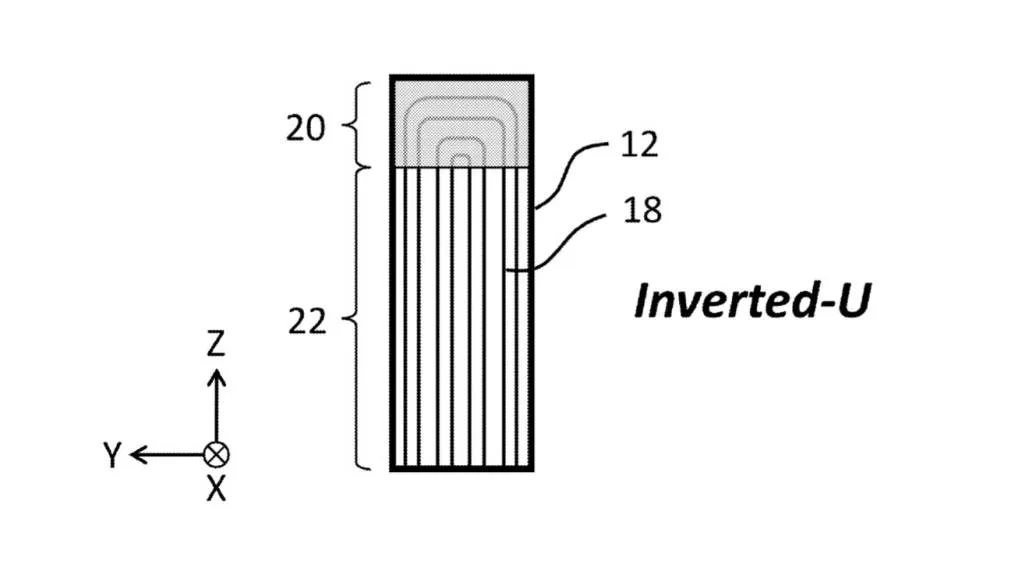
General Motors inverted
The inverted “U” stack also increases thermal delay time within the cell, causing heat to spread more slowly, according to the filing. Even if the cell overheats, the peak temperature should thus stay lower and potentially be more contained, GM claims, adding that this allows for a thermal response barrier that’s 50% thinner.
That could in future cell designs help reduce cell size, or boost energy density by cramming more active material into that space. And to tease out a greater advantage, pack size might also be smaller due to those reduced cooling needs.
But the cell format proposed here is also a more complex shape that could present manufacturing challenges, which might explain why the big battery manufacturers haven’t tried it yet.
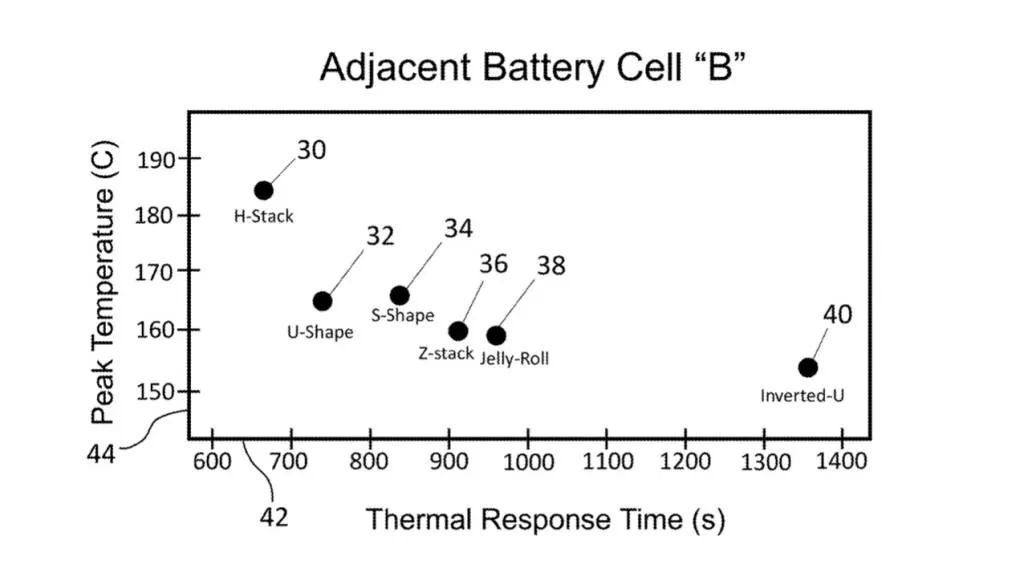
General Motors inverted
GM already appears to be on a path to use pouch, cylindrical, and prismatic cell formats, all at once, in its production EVs, and it’s emphasized that flexibility. It’s also considered some odd cell shapes in previously filed patents, also with an eye toward improved cooling.
Tesla, Lucid, and Rivian have all chosen to emphasize cylindrical cells—with apparent advantages in range and efficiency. BMW is also set to use cylindrical cells in its next-generation Neue Klasse EVs, the first of which recently entered pre-production ahead of a planned 2025 debut, with promises of substantially increased energy density.

GM working on mixed-chemistry EV battery packs
General Motors is following a handful of other automakers and battery firms in developing mixed-chemistry battery packs for electric vehicles.
GM laid out its version of this concept in a patent filing published by the United States Patent and Trademark Office (USPTO) Nov. 28, 2024. In that document, which was first filed by GM Aug. 2, 2023, the automaker discusses combining nickel manganese cobalt (NCM) with lithium iron phosphate (LFP) or other similar chemistries.
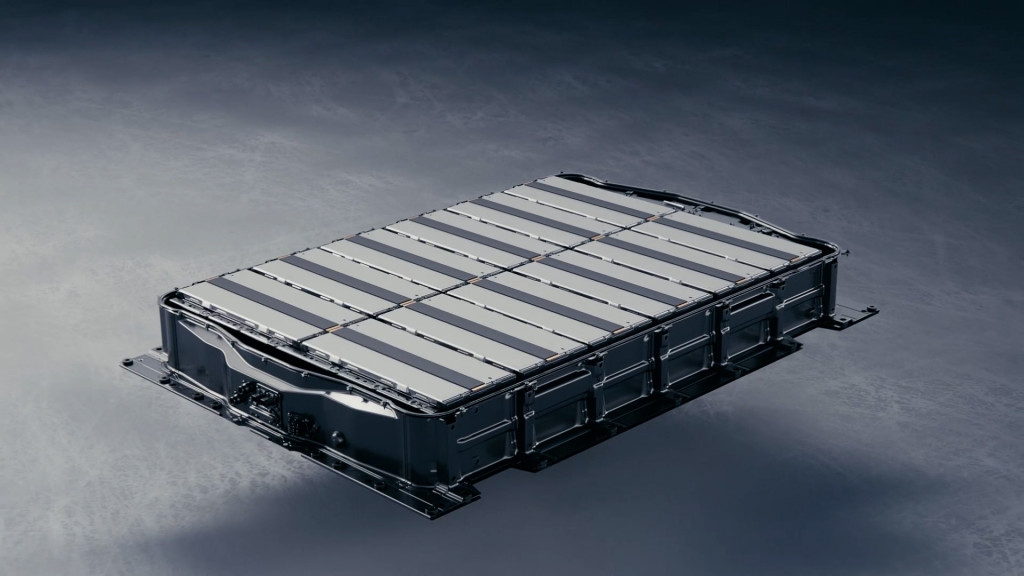
General Motors Ultium batteries
The two chemistries would be split into discreet modules, potentially with different usable capacities, according to the filing. A controller would monitor factors such as temperature and state of charge, and potentially bypass one chemistry or another in a given situation.
A mixed-chemistry pack could balance performance and cost by combining cheaper LFP battery cells with NCM cells, which offer higher power and energy density, GM notes in the filing. Two different chemistries can lead to a charge imbalance that reduce the usable capacity of a battery pack, GM adds, but the automaker hopes ability to bypass one set of cells while charging another will address that.
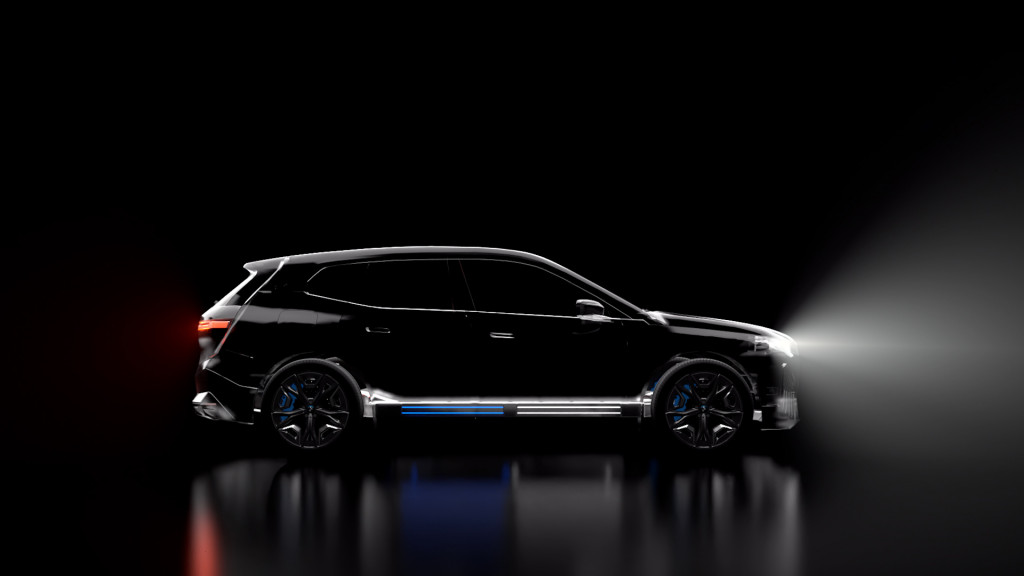
BMW iX prototype to use Our Next Energy mixed-chemistry battery pack
Certain chemistries can also be charged faster, which could enable smaller battery packs and counteract current pack inflation, which adds cost and weight, consumes more raw materials, and in the real world still often leads to longer charging times once that added charge is exhausted. Combining some of these specialized cells with slower-charging commodity cells could help make EVs more practical.
Other companies are working on mixed-chemistry battery packs. CATL recently announced one aimed at bringing faster charging to plug-in hybrids, and U.S. startup Our Next Energy (ONE) showed in 2022 how it could use mixed-chemistry tech to extract 600 miles of range from a BMW iX—nearly doubling its EPA range. Mercedes-Benz has also developed hardware that could lay the groundwork for mixed cell types.

Hyundai’s developing in-wheel electric motors
Hyundai is continuing work on in-wheel hub motors for electric vehicles, two recent patent filings indicate.
One filing, published by the United States Patent and Trademark Office (USPTO) Nov. 14, 2024, after being submitted by Hyundai’s affiliated technology supplier, Hyundai Mobis, earlier in the year, covers a drive mechanism that would allow a hub-mounted electric motor to spin a wheel. This would consist of a wheel bearing, outer race, and a speed reducer incorporating a ring gear couple to the bearing.
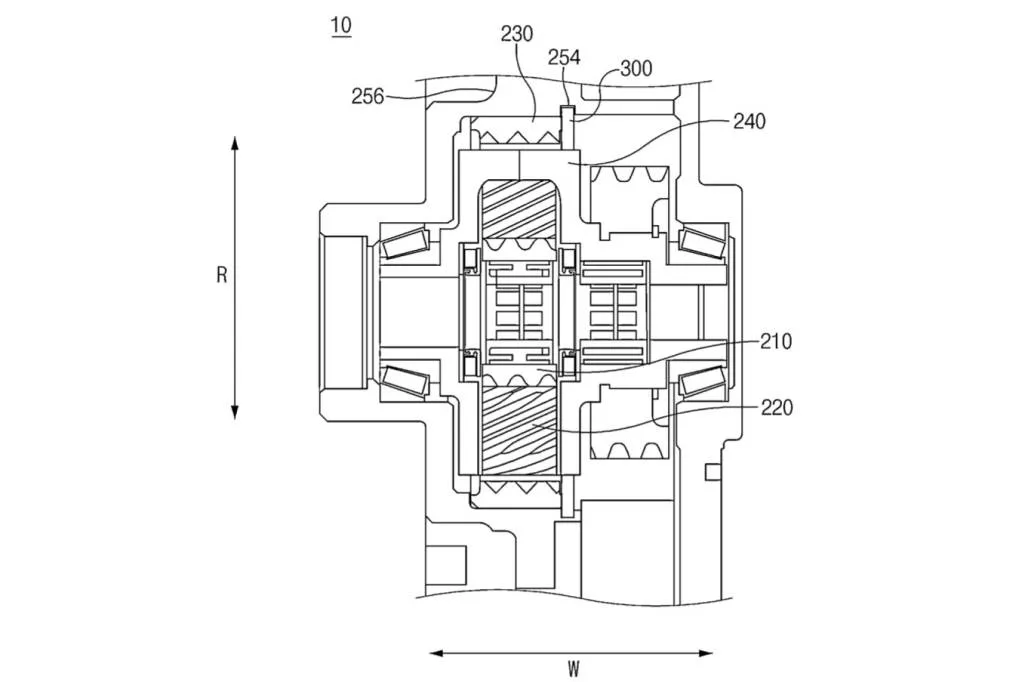
Hyundai in-wheel drive unit patent image
The second document, published by the USPTO Oct. 29, 2024, and originally filed by Hyundai Mobis Feb. 13, 2022, is for an “in-wheel working device.” This is essentially a setup for incorporating a gearshift mechanism into the rotor of a hub-mounted motor.
While not all patented ideas make it to production, these two patents indicate Hyundai is at least still developing in-wheel motors, having teased some similar concepts in the past, including the e-Corner modular steering and propulsion system. It packaged in-wheel motors along with steering and braking hardware into modules that could be installed at all corners of a vehicle, allowing more packaging freedom and the ability to rotate wheels up to 90 degrees.
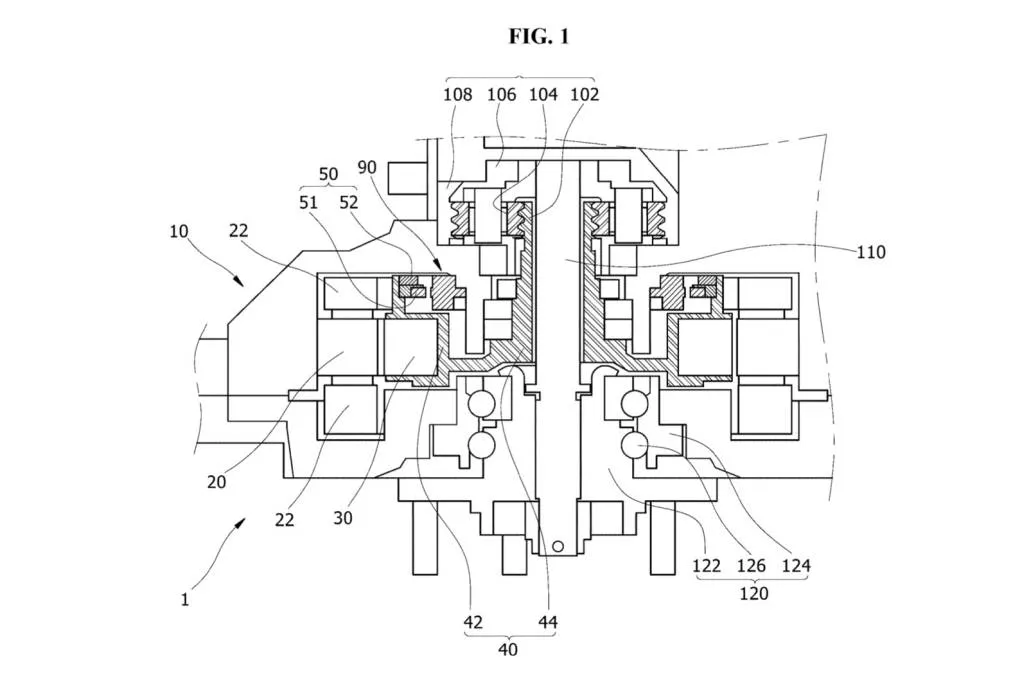
Hyundai in-wheel working device patent image
Hyundai and Kia in 2023 also unveiled an alternative design that split the difference between conventional motors and in-wheel motors. Called the Universal Drive System—or Uni Wheel—it moved motors closer to the wheels, but not into them.
Other automakers, such as Ferrari and Toyota, have patented in-wheel motor designs. China’s Dongfeng claims to be the first to use in-wheel motors in a production passenger car, although the Lordstown Endurance pickup truck also used them before its production stalled. Aptera also plans to use in-wheel motors for its three-wheeler, but that vehicle will be an autocycle, not a car.

2025 Subaru Solterra prices cut by up to $7,000
- The 2025 Subaru Solterra costs $39,915
- Subaru cut the EV’s base price by $6,500 compared to the 2024 model
- Subaru works the $7,500 tax credit toward lower lease numbers
Like its Toyota cousin, the bZ4X, the 2025 Subaru Solterra receives significant price cuts for the new model year, plus a new dark-themed appearance package.
Subaru confirmed 2025-model-year pricing Friday, including a new base price of $39,915 for the entry-level Premium grade, with destination. That price is $6,500 less than the 2024 model, although some of that is countered by an increase of the destination charge from $1,345 to $1,420.
The Solterra Limited grade also receives a $6,500 price cut, bringing its MSRP to $43,415 with destination. This grade adds features like 20-inch wheels, power-adjustable front seats, a power tailgate, an 11-speaker Harman Kardon audio system, and a 12.3-inch touchscreen, compared to the Premium’s 8.0-inch screen.
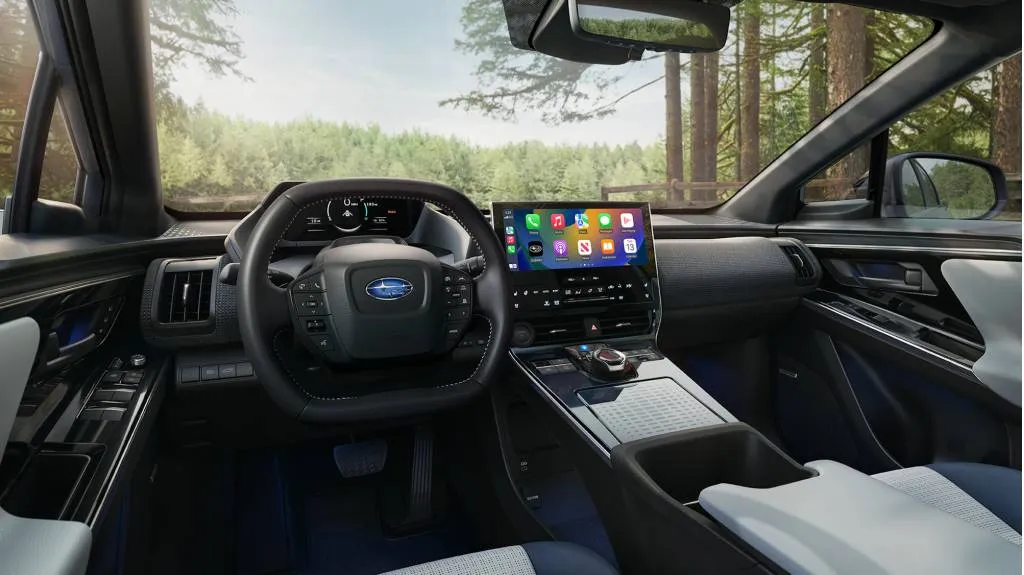
2025 Subaru Solterra
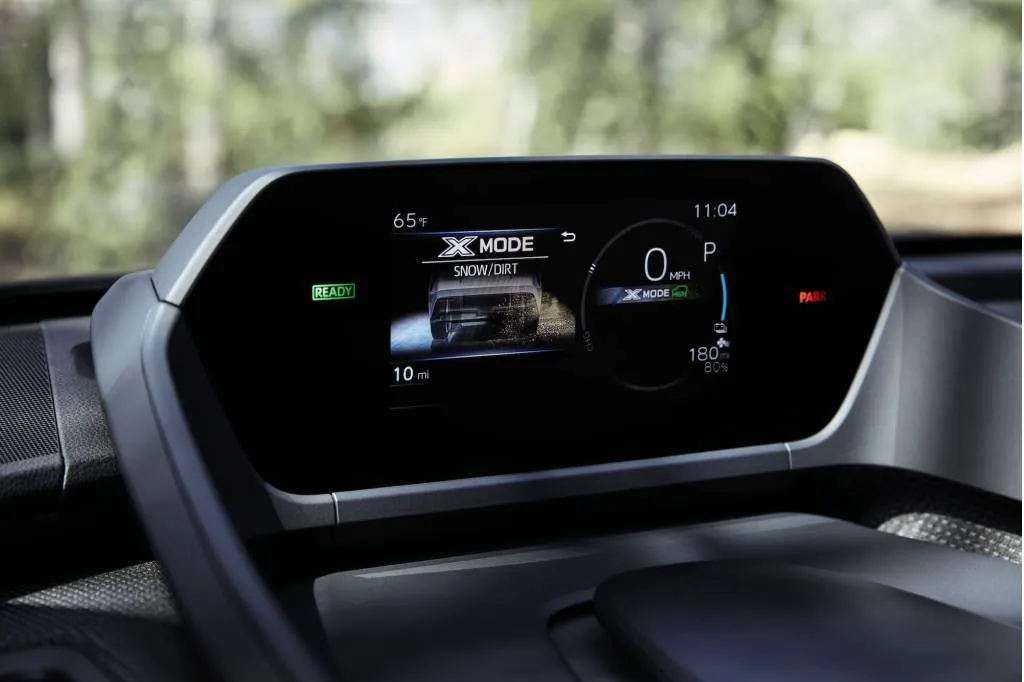
2025 Subaru Solterra
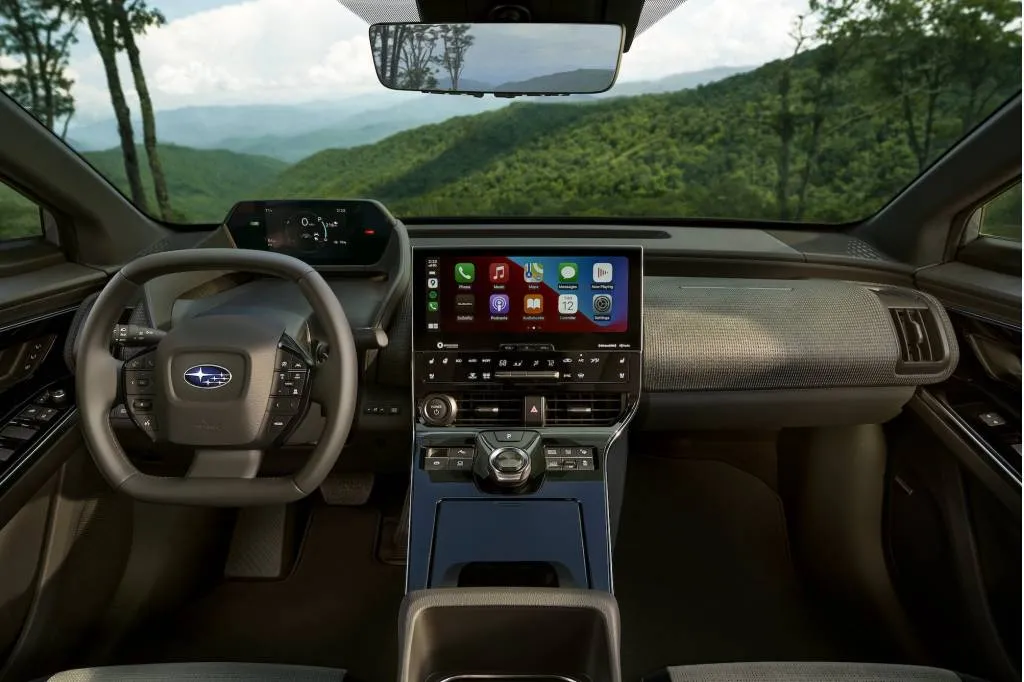
2025 Subaru Solterra
Touring models now start at $46,415—$7,000 less than the 2024 model year. They get additional convince features, including a moonroof, a digital rearview mirror and ventilated front seats (heating is standard on all models).
As with the 2024 model, Subaru claims that the 2025 Solterra “will qualify for applicable tax credits of up to $7,500 for some consumers.” Despite not being assembled in the U.S., and not qualifying for the purchase credit, Solterra leases are indeed subsidized by the so-called “leasing loophole” that allows captive credit companies to claim imported EVs to be leased as commercial fleet vehicles. Automakers and their credit firms offering the lease are under no obligation to pass the full credit along to consumers. Meanwhile, the EV tax credit in its various forms is reportedly being targeted by the incoming Trump Administration.
For an additional $500, the new-for-2025 Onyx Edition gives the Touring grade black wheels and exterior trim and two-tone color options. This makes it similar to the Nightshade Edition that joins the Toyota bZ4X lineup for 2025. The Toyota has also gotten less expensive, with price cuts of up to $6,000.
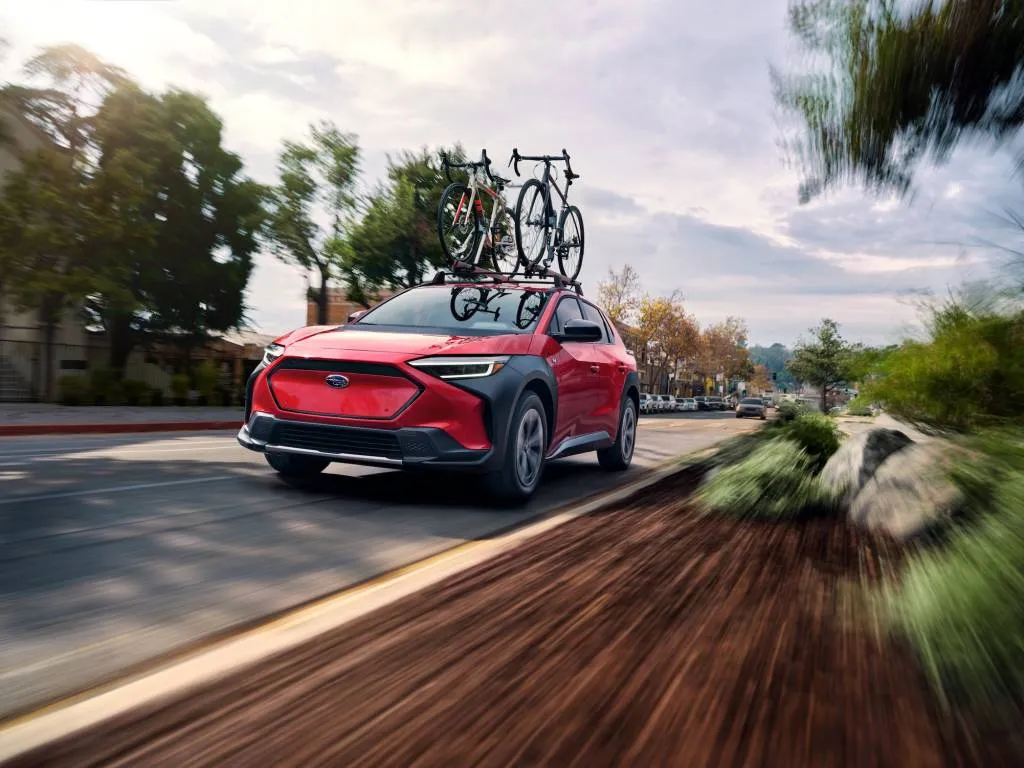
2025 Subaru Solterra
While the bZ4X is available with front-wheel drive or all-wheel drive, in keeping with the Subaru ethos, the Solterra is available with dual-motor all-wheel drive only. Subaru lists output as 215 hp and 249 lb-ft of torque, with power supplied by a 72.8-kwh battery pack as in the bZ4X. EPA range is unchanged, at 227 miles for Premium models and 222 miles for other grades, which have larger 20-inch wheels.
Subaru launched the Solterra as a 2023 model and made a number of changes for 2024, including an improved battery conditioning system that allows for faster charging. DC fast charging from 10% to 80% takes about 35 minutes, Subaru estimates. That still makes the Solterra one of the slower-charging electric crossovers. In a test drive of the 2024 Subaru Solterra, we found that while charging remains at a crawl, it’s now in the same efficiency ballpark as the rival Hyundai Ioniq 5 and Volkswagen ID.4.
